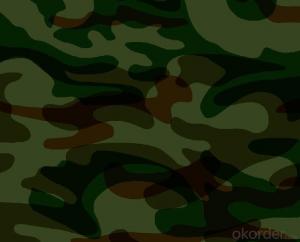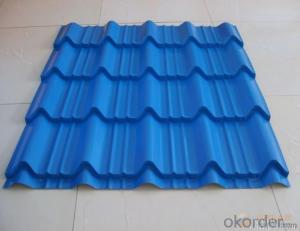PPGI DX52D with Best Quality in China Low Price
- Loading Port:
- China main port
- Payment Terms:
- TT OR LC
- Min Order Qty:
- 50 m.t.
- Supply Capability:
- 10000 m.t./month
OKorder Service Pledge
OKorder Financial Service
You Might Also Like
Item specifice
1. PPGI DX52D with Best Quality in China Low Price
With GI as base material, after pretreatment (degrease and chemical treatment ) and liquid dope with several layers of color, then after firing and cooling, finally the plate steel is called pre-painted galvanized (aluzinc) steel. Pre-painted galvanized steel is good capable of decoration, molding, corrosion resistance. It generally displays superior workability, durability and weather resistance.
2.Main Features of PPGI DX52D :
• Excellent process capability
• Smooth and flat surface
• Workability, durability
• Excellent heat resistance performance
• High strength
3.Pre-Painted Galvanized/Aluzinc Steel Coil Images


4.Pre-Painted Galvanized/Aluzinc Steel Coil Specification
Standard: AISI, ASTM, BS, DIN, GB, JIS
Grade: DX51D, DX52D
Thickness: 0.17-2.0mm
Brand Name: KMRLON
Model Number: coil
Type: Steel Coil
Technique: Cold Rolled
Surface Treatment: Coated
Application: Boiler Plate
Special Use: High-strength Steel Plate
Width: 20-1250mm
Length: customized
commoidty: pre-painted galvanized steel coil
Thickness: 0.13-4.0mm
width: 20-1250mm
zinc coating: 40-180g/m2
printing thickness: top side: 20+/-5 microns, back side: 5-7 microns
color: all RAL color
surface treatment: color coated
coil weight: 4-7 tons
coil ID: 508/610mm
packaging: standard seaworthy packing
5.FAQ of Pre-Painted Galvanized/Aluzinc Steel Coil
1. What’s the brand of the paint?
We use the best brand of all of the word—AKZO.
2. How to guarantee the quality of the products?
We have established the international advanced quality management system,every link from raw material to final product we have strict quality test;We resolutely put an end to unqualified products flowing into the market. At the same time, we will provide necessary follow-up service assurance.
3. How long can we receive the product after purchase?
Usually within thirty working days after receiving buyer’s advance payment or LC. We will arrange the factory manufacturing as soon as possible. The cargo readiness usually takes 15-25 days, but the shipment will depend on the vessel situation.
- Q:explain what happen if carbon steel is exposed to an oxygen rich atmosphere at elevated temperature inside a furnace.
- Assuming the steel isn't actually melted, two things will happen. First, a layer of iron(ii) oxide, FeO will slowly develop on the surface, getting thicker over time. This layer is usually poorly bonded to the metal surface, it tends to flake off, exposing fresh metal. This is known as mill scale, it's also known as wustite which is the mineral term. Second, the surface of the steel will become decarburized, essentially becoming pure iron, not steel. The depth of the decarburized layer depends on the temperature, time, and the diffusivity of carbon in the steel at the given temp. This has some implications to engineering, in hot-rolling or forging of steel shapes for example. It's often the case that the stress and strain in a material is greatest at or near the surface. Therefore the weakened, decarburized layer at the surface may have a much greater detrimental effect on the steel's performance than might be expected. In a more specific example, die and tool steels depend on their carbon content for their strength and wear resistance, Therefore if such steels are heated in an oxidzing atmosphere, wear resistance is totally destroyed: The thin decarburized iron layer will be extremely soft and malleable.
- Q:With the Reduced weight of steel,wouldn't the projectile be at a much higher velocity when fired causing more damage?I mean l couldn't steel be worked to seal the bore,not damage the rifling and still cheap enough to mass produce,and be light enough to carry much more ammo.
- Well trying to force that down a rifled barrel would be a funny trick. Please have a friend or two there to record it so they can put the blowing up of your rifle on youtube so people can learn what happens when idiots try stupid things. I'd say you should but you'll likely be dead or in hospital from the injuries. To expand your knowledge: Until you get to NIJ class 3 body armor any lead core high velocity bullet of FMJ form will go through like it's not even there. Oh pretty much anything with soft point ammunition at over 2,000fps velocity will go through with devastating effect. So lets see .. oh yes time to ban the .30-30 Winchester for civilian use. All the typical rifle caliber ammunition designated by the military as armor piercing has a copper alloy jacket around either a hardened steel core or more commonly a lead core with a hardened steel or tungsten alloy penetrator centered in that.
- Q:How are steel coils inspected for chemical composition using spectroscopy?
- Steel coils can be inspected for their chemical composition using spectroscopy, specifically techniques like X-ray fluorescence (XRF) or laser-induced breakdown spectroscopy (LIBS). In XRF, an X-ray beam is directed onto the surface of the steel coil, causing the atoms in the sample to emit characteristic X-ray fluorescence radiation. By analyzing the energy and intensity of these emitted X-rays, the elemental composition of the steel can be determined. XRF is a non-destructive and rapid technique, allowing for quick and accurate assessment of the chemical composition of the steel coil. LIBS, on the other hand, involves focusing a laser beam onto the surface of the steel coil, creating a high-temperature plasma. The plasma emits light, which is then collected and analyzed using a spectrometer. The emitted light contains characteristic atomic and ionic emissions, allowing the identification and quantification of various elements present in the steel. LIBS is also a non-destructive technique, providing real-time results and requiring minimal sample preparation. Both XRF and LIBS offer advantages in terms of speed, non-destructiveness, and ease of use for inspecting steel coils for their chemical composition. These spectroscopic techniques play a crucial role in quality control and assurance, ensuring that the steel meets the required specifications and standards for various industrial applications.
- Q:What types of steel are used in steel coils?
- There are various types of steel used in steel coils, including carbon steel, stainless steel, galvanized steel, and high-strength low-alloy steel.
- Q:How are steel coils used in the production of agricultural systems?
- Steel coils are used in the production of agricultural systems as they are often shaped into various components like frames, supports, and structures. These components provide strength, durability, and stability to agricultural equipment such as tractors, harvesters, and irrigation systems, ensuring their long-term functionality and reliability in demanding farming environments.
- Q:I just started playing guitar last year. I never changed the chords. When my sister started taking guitar lessons her teacher said that she needed to change the chords. When i bought the guitar it came with steel strings but i bought nylon strings because they are easier on the fingers. The problem is i already tuned up the guitar but it sounds really bad like if it was not tuned. What can i do about this?
- Guitars okorder /
- Q:which metals have a higher density than steel? and how does the density compare to steel( example: tungsten carbide is 2x [i think] more dense than steel.)
- This Site Might Help You. RE: what metals are more dense than steel? which metals have a higher density than steel? and how does the density compare to steel( example: tungsten carbide is 2x [i think] more dense than steel.)
- Q:Can steel coils be used in the manufacturing of machinery and equipment?
- Yes, steel coils can be used in the manufacturing of machinery and equipment. Steel coils are versatile components that provide strength, durability, and stability to various industrial applications. They can be shaped, cut, and formed into different parts and components necessary for the machinery and equipment manufacturing process. Steel coils are commonly used in the production of gears, shafts, frames, brackets, and other structural elements. Additionally, they can be processed further to create specialized components such as springs or fasteners. The use of steel coils in machinery and equipment manufacturing ensures that the end products are of high quality, capable of withstanding heavy loads, and have a long lifespan.
- Q:What are the dimensions of steel coils used in the transportation equipment industry?
- The dimensions of steel coils used in the transportation equipment industry can vary depending on the specific requirements and applications. However, there are some common dimensions that are widely used. The width of steel coils used in the transportation equipment industry typically ranges from 600mm to 2000mm (24 to 78 inches). This width is chosen to ensure compatibility with the machinery and equipment used for transportation, such as trucks, trailers, and railcars. The thickness of steel coils can vary greatly depending on the specific application and the desired strength of the material. However, common thickness ranges for transportation equipment industry steel coils are typically between 0.5mm and 6mm (0.02 to 0.24 inches). The inner diameter of steel coils used in the transportation equipment industry is typically standardized at either 508mm (20 inches) or 610mm (24 inches). This standardization allows for easy handling and compatibility with the machinery used in the industry. The outer diameter of steel coils can vary depending on the width and thickness of the coil. However, common outer diameter ranges for transportation equipment industry steel coils are typically between 1000mm and 2200mm (39 to 87 inches). It is important to note that these dimensions are not fixed and can be customized based on specific requirements and applications within the transportation equipment industry.
- Q:When i was 15 i got caught steeling at Super A yes i know i cant believe it. They didnt call the cops or anything they released me to my aunt they took my name and adress and everythimg they said it wouldnt be on my record. But I'm not so sure. Will it be on my record if they didn't call the cops?i live in california. Is there any way i can check my record?
- Steeling? What's that? Did you take a piece of steel and weld it? I am confused?
1. Manufacturer Overview |
|
|---|---|
| Location | |
| Year Established | |
| Annual Output Value | |
| Main Markets | |
| Company Certifications | |
2. Manufacturer Certificates |
|
|---|---|
| a) Certification Name | |
| Range | |
| Reference | |
| Validity Period | |
3. Manufacturer Capability |
|
|---|---|
| a)Trade Capacity | |
| Nearest Port | |
| Export Percentage | |
| No.of Employees in Trade Department | |
| Language Spoken: | |
| b)Factory Information | |
| Factory Size: | |
| No. of Production Lines | |
| Contract Manufacturing | |
| Product Price Range | |
Send your message to us
PPGI DX52D with Best Quality in China Low Price
- Loading Port:
- China main port
- Payment Terms:
- TT OR LC
- Min Order Qty:
- 50 m.t.
- Supply Capability:
- 10000 m.t./month
OKorder Service Pledge
OKorder Financial Service
Similar products
New products
Hot products
Related keywords




























